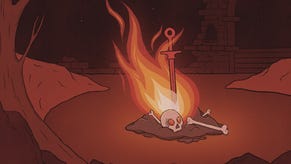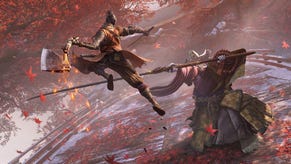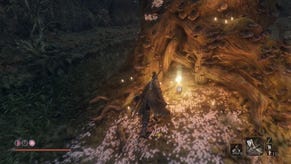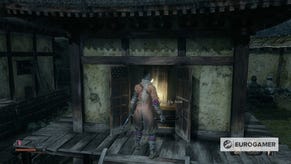Sekiro, Samsara and From Software's cycles of death
Git enlightened.
Huge Sekiro spoilers ahead.
In Buddhism, the three marks of existence are impermanence, non-self and suffering. It's our failure to accept these things that leads to Samsara: an endless, painful cycle of reincarnation and an aimless wandering through a ceaseless existence.
Like weeping over wilted cherry blossoms when autumn arrives, we struggle against transience, and so we suffer. We cling onto fixed identities in ourselves and others, expecting to step into Heraclitus' river over and over, and so we suffer. Perhaps most painfully, we reject suffering itself, treating its presence in our lives as a failure, rather than a natural occurrence. And so we suffer.
"Sometimes, I feel obsessed... with this insignificant thing called 'self'. But even so, I am compelled to preserve it."
A line easy to imagine from one of Sekiro's Buddhist monks, but this lament is from the lips of Dark Souls 2's Lucatiel of Mirrah. Sekiro may be the first of From's Soulslikes to have you grapple through valleys overlooked by stone Buddhas, but Buddhist themes have been present since we first awoke in the Undead Asylum. Themes of ego, and transience. Of the conflict caused by our perception dividing reality into disparate, binary oppositions. Of endless cycles, and endless suffering. Hollow gods and monarchs grasping at former glory. Academics driven to communion with malevolent entities on the path to ascension. Shinobi caught in purgatorial, deathless struggles somewhere between duty and compassion.
We play a part in these stories, too. Caught in our own recurrent loops of struggle, death and resurrection. We'll get what we think we want, eventually. Then hit 'new game plus', willingly perpetuating the same cycle that has stolen the sanity from the creatures we've just spent hours putting out of their misery.
Ever get the feeling that - like a crotchety, tamarin-bearded sensei hitting us over and over again with a bamboo stick - From might be trying to teach us something?
Sekiro's exploration of this karmic ouroboros manifests itself within two parallel cycles. One of stagnating immortality, the other perpetual violence.
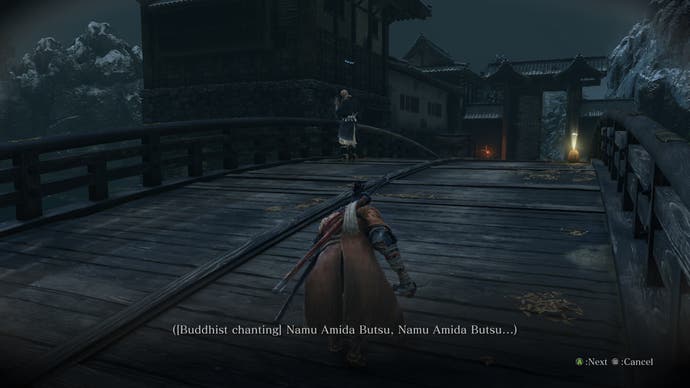
"Asura" or the Japanese "Ashuradō" is one of the six Buddhist realms of existence Tibetans call "the wheel of life". A demon realm, characterised by anger, jealousy and constant war. One said to be on the path of 'Shura' is trapped in relentless conflict, seeking only to gain greater martial prowess. For Wolf, the lure of Shura remains a constant threat, and one the sculptor sits as a monument to the dangers of.
"Every buddha I carve is an incantation of wrath," he laments. "The fate of those who owe a deep karmic debt. You'll understand when you try carving one for yourself someday."
If we share enough saké with the Sculptor, we'll learn of his past as a Shinobi, and the fate of his own left arm, cut off by lord Isshin "for his own sake". At one point, the Sculptor interrupts his own explanation of the prosthetic arm's potential.
"I must calm myself," he says. "The more I speak of bloodshed, the more demonic my sculptures will become." It feels like recognition of our own fascination with crafting and upgrading ever more powerful murder tools. In the Sculptor, we have a character so bitterly acquainted with the price of thoughtless bloodshed, he interrupts his own tutorial out of fear of the passion he can hear his own voice.
In the game's final hours, the Sculptor will disappear. The only clue we're given to his destination is from a vendor who'll tell us he "stumbled off mumbling something about 'the flames...' ". We never see him again, but if we return to the battlefield outside Ashina castle, we'll find a burning demon, consumed with fiery hatred, thrashing a phantom arm.
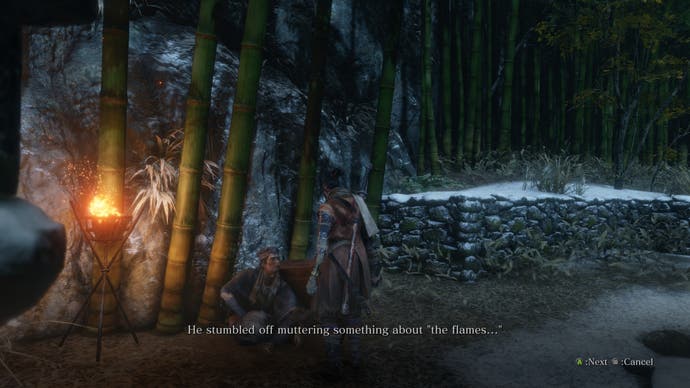
It's hard not to see the parallels between the violent, all-consuming haze of Shura and us, as players, hammering the resurrect button over and over, singularly focused on revenge, attainment and progress.
With its ghosts and giants and Oni, it may even be that the Ashina we explore is not a real place at all, but an endless, purgatorial conflict, fought by those who fail to attain enlightenment.
"Where's all that hatred go? Haven't you ever wondered?" asks a woman you meet outside Ashina castle. "There's no end to war, no matter what this old hag says. Your duties will never change either, that's just how it is."
That obsession with self, that Lucatiel hinted at, naturally leads to an obsession with self preservation. Dark Souls' undead curse is presented in Sekiro as what young master Kuro calls "the chains of stagnation bred by the dragon's heritage".
When we put down the headless Guardian Ape and pluck the wriggling centipede from its bloody neck stump, we learn the Rejuvenating Water is infested with parasites. What's presented as a false immortality, an impure anthesis of the dragon's heritage, may, in fact, be a closer parallel than we realise. After all, what's a parasite, if not a creature that steals our bodily autonomy for its own ends? Not all that different from a duty that sees Wolf unable to die in peace. The 'iron code', it turns out, is a fitting name - it's the same material shackles are made from. The Wolf's bonds may give him a purpose, but they also tether him to an eternity of undeath.
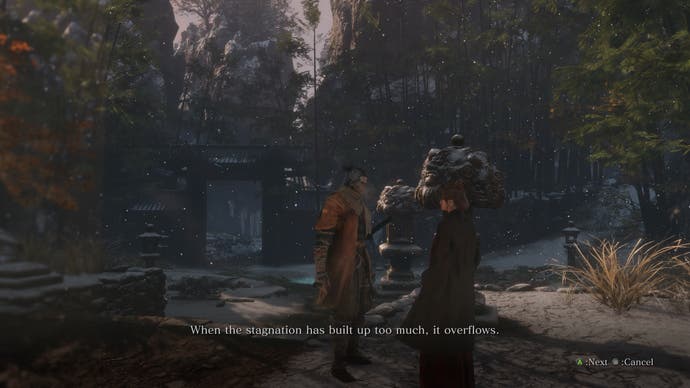
Dark Souls introduced us to two serpents, each with their own agenda, each supposedly in opposition to the other. One would try to convince us to sacrifice ourselves to prolong the age of fire, the other to forsake the linking ritual and usher in an age of dark. In later games, we'd learn the choice we made was irrelevant. A linked fire always faded, and a snuffed flame always burst anew from the embers, eventually.
Part of enlightenment, especially in Zen Buddhism, means coming to the realisation that disparity is a myth; that there's no real difference between light and dark, or between self and other. This is what the yin yang symbol, itself reminiscent of two interlinked serpents, is meant to signify. The actual choice we made at the end of Dark Souls was less important than the fact the serpents had manipulated us into making a choice to begin with. By choosing a side, by valuing one state of existence over another, we embrace the disparity that keeps the world from reverting back to its original, peaceful state.
The weight of the world, it would seem, is only an issue if you try to hold the thing.
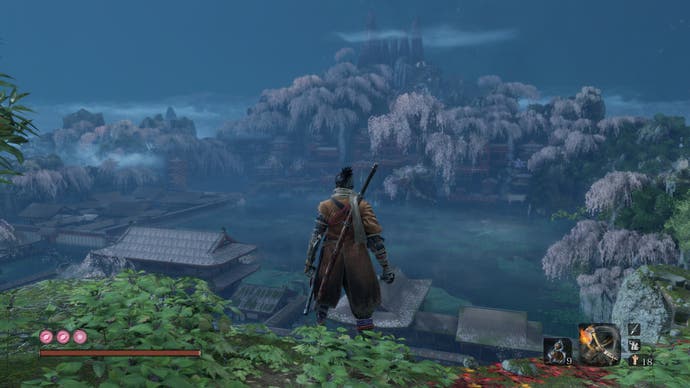
There are four endings to Sekiro, and although not the most difficult to obtain, the one I find most satisfying is the 'purification' ending. Wolf is given peace, removing his own head to a gush not of blood, but of Sakura - delicate, beautiful and ultimately transient cherry blossoms.
Somewhere between memes and marketing, From Software's games have come to be associated with death, and the equation of death with failure. Sekiro's purification ending shows Wolf embracing his own end, not as failure, but acceptance. This same acceptance is Wolf's last gift to his young master, who speaks these words over Wolf's grave:
"I, too, will live for every moment. Then I will pass on."
'Prepare to Die' might not have been a threat, after all. It's only once Kuro, with the help of Wolf's sacrifice, is prepared to die, that he's ready to start to live.






